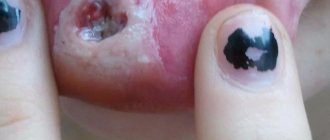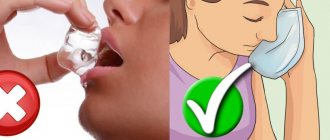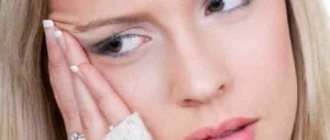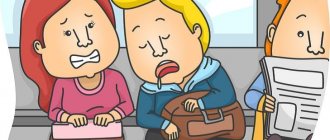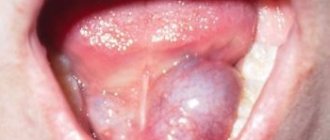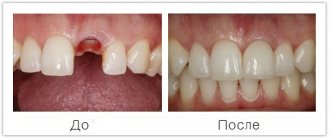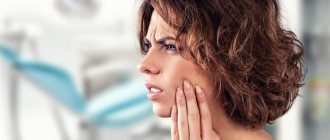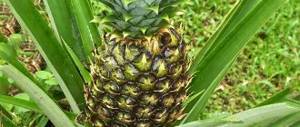Reasons for the habit
The bad habit of biting your lips doesn’t just appear. It can form at any age, but usually it is the period of childhood and adolescence. In most cases, the habit indicates problems of a psychological nature.
The main reasons for the habit:
- Lack of parental attention. The child receives little love from his parents. He needs his mother's hugs, kisses, and praise. He has a bad relationship with his family. Instead of love and affection, he usually receives punishment for bad behavior and bickering. In such cases, the child involuntarily begins to slightly bite his lips, and may also gnaw on the inside of his cheeks. After some time, this unconscious movement turns into a habit.
- Negative emotions. Adults bite their lips or cheeks when they cannot control their emotions. Some are hysterical, and there are those who simply silently bite their cheeks in the hope of getting rid of emotional discomfort. The habit may occur when stress is experienced at work. The person reacts too emotionally to this situation. He is overwhelmed by frequent anxious feelings and, in order to calm down, he bites his lips and cheeks. In this way he inflicts pain, wanting to quickly bring himself to his senses. Sometimes a person bites his cheeks even while laughing.
- Desire to get rid of rough skin. In frost or strong wind, lips become chapped. Their surface becomes rough and the skin cracks. This creates some discomfort. Some people end up chewing off the flaky crust.
Another reason when they bite from the inside of the cheek is that the person is in thought. This simple action helps keep him focused on the problem and not lose focus. After he has thought through all the important issues, the action stops.
If a child had a good, carefree childhood, then he will not have the bad habit of biting his cheeks. Otherwise, you should first find out the reason why this disorder was formed and later try to eliminate it.
Types of pathologies
All deformations cause problems of various types, including external changes in a person’s face.
Deep
The upper row of teeth greatly overlaps the lower one, when ideally the upper teeth should overlap the lower ones by 1/3. This type of bite is also called traumatic, since patients’ enamel wears off over time and teeth are destroyed precisely against the background of this anomaly.
Causes unpleasant consequences for the patient:
- Injuries to the oral mucosa.
- There is a strong load on the front teeth, hence the pain.
- Speech defects.
- Visual changes in facial features.
- Difficulty eating.
The face appears small, the lower lip protrudes forward, and if a person tries to press it in, it becomes thin over time. After correction, the shape of the face and lips is normalized.
The pathology is dangerous because it severely injures the gums, causing periodontal disease, in which the patient loses teeth. In addition, with a deep bite, problems with the respiratory system may occur.
Treatment is recommended in childhood, when the jaws have not yet formed.
During correction, the use of a brace system, prosthetic replacement of lost teeth, consumption of hard foods, and timely sanitation of the oral cavity are indicated.
In adults, treatment is carried out using permanent braces, which are placed on the front teeth of the upper jaw.
Open
The upper and lower teeth are not connected. The pathology occurs in children in 90% of cases and is considered a severe form of jaw deformation. Dentists distinguish two types of open bite:
- Front. The anomaly occurs most often; these disorders are associated with other diseases, for example, rickets.
- The lateral view of the anomaly is less common.
It is manifested by several symptoms, such as a constantly slightly open mouth or, conversely, closed to hide the defect.
It is difficult for the patient to bite and chew food, the oral mucosa is constantly dry, and the face becomes asymmetrical over time.
Speech impairment is dangerous, and constant breathing through an open mouth provokes problems with the respiratory system. The inability to chew food normally affects the functioning of the digestive tract.
When correcting this pathology in children, the doctor recommends eliminating bad habits such as thumb sucking and mouth breathing. A child's diet requires hard foods.
Wearing braces is also indicated, and in case of serious violations, surgical intervention is required. Adults are usually recommended to wear permanent braces.
Cross
The jaw moves to the side, due to its insufficient development on one side. The displacement can be bilateral or unilateral, in the front or side.
The problem is best seen when smiling because the teeth overlap.
The patient cannot chew and swallow food normally, and speech is impaired. A person with this pathology chews food on one side, which causes teeth to deteriorate faster, enamel wears off, caries and periodontal inflammation occur. The pathology is often accompanied by pain and a crunching sound in the jaw when opening the mouth.
There are two types of crossbite:
- Buccal, when the upper or lower jaw can be greatly expanded or narrowed.
- Lingual, when the upper row of teeth is wide or the lower row is narrow.
The face may be severely deformed and skewed. After correction, the features become symmetrical, and the oval of the face takes on a normal shape.
The disease is most often treated over the age of 7 years with the help of braces and removable appliances that straighten the dentition.
Patients over 15 years of age with an advanced form are prescribed surgical intervention before and after installation of a brace system.
Distal
The upper and lower jaws are deformed. This condition of the oral cavity causes a severe discrepancy in the size of the jaws. One of the main symptoms of a prognathic bite is protrusion of the upper lip.
The violation causes improper distribution of the load - the back part of the dentition takes on the main work when chewing food. The patient's teeth are more susceptible to caries and complete destruction.
Anomalies are divided into types:
- The upper jaw is correctly developed and the lower jaw is underdeveloped.
- The upper jaw is too developed and the lower jaw is not enough.
- Severe protrusion of incisors.
- The lower jaw is normal, but the upper jaw is strongly protruded forward.
The classification applies only to adults, since in children with baby teeth the bite is not fully formed.
With this type of bite, the person’s face is greatly deformed, the chin seems too small, and the facial features are unnatural and childish.
After correction, the shape of the face is restored, the patient looks serious and mature.
The consequences of pathology appear gradually and affect the health of teeth and gums. Periodontal and temporomandibular joint diseases develop. It is difficult for patients with an anomaly to install a prosthesis.
Correction of the distal bite is carried out using braces and special devices for children, which restrain the growth of the upper jaw.
Mesial
The lower jaw remains underdeveloped, and the upper teeth overlap the lower ones. The main symptom of the disease is a protruding chin. This problem is visible to the naked eye.
With a mesial bite, a person cannot chew normally and problems with the gastrointestinal tract arise. Patients complain of difficulty swallowing, which also does not have the best effect on the health of the body.
The upper teeth undergo enormous stress and are quickly worn away, inflammatory processes occur in the oral cavity, periodontal disease and caries develop.
Mesial bite provokes diseases of the temporomandibular joint, causing headaches, ringing in the ears and dizziness.
The face becomes courageous, the chin seems heavy. For a man, this situation cannot be called a minus, but women suffer. After correction, the chin does not protrude and the face is straightened.
This disease is treated with braces, myotherapy, and surgery. The complexity and duration of rehabilitation depends on the severity of the jaw deformity.
Treatment is especially effective in children under 12 years of age.
The defect manifests itself with certain symptoms:
- jaw crunch;
- headaches and facial pain;
- hearing loss and congestion in the ears;
- dry mouth.
The disease develops from premature tooth loss and is treated with the installation of dentures and braces.
There can be several types of malocclusions. Let's take a closer look at them.
Deep bite
In dentistry, deep bite is considered the most common defect. Its main feature is the following: when the jaws close to each other, the upper row of teeth overlaps the lower one by a third.
In this case, there is a large load on the front teeth; due to their contact with the oral mucosa, injury can occur. With such a defect, a violation of the aesthetics of the face occurs, that is, the lower part visually becomes shorter, the lips acquire an unattractive position.
Treatment of deep bites should begin as early as possible, since this pathology leads to loosening and tooth loss. Ideally, treatment should begin at an early age. For this purpose, plates and braces are used, thanks to which the teeth are aligned, and thus this problem is corrected.
Open bite
An open bite is a type of anomaly in which there is a small gap between the rows of teeth. At the same time, a person with such a defect always has his mouth slightly open. As a result, he feels discomfort, since due to this problem there is always a dry mouth, the functions of digestion, speech, and breathing are disrupted.
DETAILS: Means for correcting bite
The reasons for this anomaly can be poor heredity, jaw deformation, and bad habits at an early age, for example, thumb sucking, nail biting, as well as infectious diseases suffered by the mother during pregnancy.
Open treatment is special for each age. During the period of early treatment, myogymnastics has proven itself very well in children. In order to wean a child from bad habits, special plates with a tongue rest are used.
If treatment occurs at an older age, then various mouth guards are recommended to correct the problem. Typically, better results are achieved if treatment is started early.
Crossbite
In dentistry, there is such a type of malocclusion as crossbite. It is a serious disorder and can occur in both adults and children.
A distinctive feature of this pathology is the crossing of the dentition during the period when the jaws close.
There are more than enough reasons for the development of crossbite. This is both heredity and improper formation of teeth in childhood. This can also be caused by the fact that a person often develops caries.
The following forms of crossbite are distinguished:
- Buccal - represents a narrowing of the upper teeth and widening of the lower ones. This form can be either one-sided or two-sided.
- Lingual - it can also be unilateral or bilateral. Its peculiarity lies in the fact that there is an expansion of the upper dentition and a narrowing of the lower one.
- Buccal-lingual is a combination of the first and second forms.
The most unpleasant thing with such a defect is that the aesthetics of the face is impaired, and the chewing function is also impaired, which leads to problems with the gastrointestinal tract.
If such an anomaly is detected at an early age, then doctors suggest performing myogymnastics and grinding the incisors. If crossbite is detected late, patients are offered treatment using various medical devices.
Distal bite
One of the anomalies of dental malocclusion is distal. In this case, when the dentitions close, the upper one moves forward slightly in relation to the lower one.
The reasons for the formation of a distal appearance are varied. This can be a sore throat, breathing problems, various bad habits, and genetic predisposition can also lead to this.
This type of behavior entails disastrous consequences. Chewing and swallowing functions are impaired. There is a very high risk that caries, periodontal disease, and periodontitis may develop.
Treatment of this anomaly in children occurs with the help of dental guards and trainers, which help the development of the lower jaw, and at the same time prevent the development of the upper jaw. In adults, braces are used.
Mesial bite
Consequences
Biting your lips indicates that a person is very worried, worried, stressed, or experiencing other unpleasant sensations. He develops small wounds. The lips begin to become inflamed, and this is fraught with the fact that they begin to react to spicy and salty foods, cold and hot water. This creates an unpleasant feeling of very chapped lips.
Another negative consequence is the possibility of contracting an infection. Microwounds are an excellent environment for the development of bacteria that lead to skin inflammation. As a result, various diseases can form and actively develop, one of them is cheilitis: unsightly herpes appears, which also worsens the appearance of the lips and face.
For girls, bitten lips mean the inability to apply lipstick due to the excessively red border of the lips. The cosmetics will lay down in an uneven layer and will further emphasize the unsightly cracks. This is especially important for women whose professional activities involve communicating with people.
Why does the interlocutor bite his lip?
Biting during a conversation is an important sign that you should always pay attention to, regardless of whether the trouble occurred with the person himself or with an opponent.
The bitten lip of the interlocutor indicates an inadvertent offense inflicted on him. Therefore, in order to avoid troubles in the future, it is worth finding out the reason and apologizing.
However, sometimes such a situation may indicate that an unpleasant topic for the person was touched upon in the conversation. In this case, it is recommended to change the course of the conversation.
Biting your lips is not the most pleasant event, but, as a rule, it does not carry serious consequences. The best solution after such an incident is to remain silent for a while and pay attention to what others say and how others behave.
Correction
Getting rid of the habit of biting your lips is difficult, but it is possible. This will take 10–40 days.
The first thing to do is to find the reason for this habit. You need to listen to yourself, focus on your behavior. You will notice under what circumstances you start biting your lips. You need to try to control yourself and not commit such manipulations.
It is important to learn to control your actions and emotions as well. In moments of strong emotional outbursts and when thoughtful, try to restrain yourself from biting your lips. Remember what the consequences of this addiction are: inflammation, cracks, burning sensation on the lips.
Other recommendations to help you overcome your bad habit:
| № | Method name | Description |
| 1 | Quiet lifestyle. | Try to protect yourself from stressful situations as much as possible. It is important that positive emotions prevail. If this cannot be avoided, then learn how to relieve stress in a pleasant way. You can go for a relaxing massage or go to spa treatments. It is convenient to carry out aromatherapy and color therapy at home. Sometimes a regular bath with warm water will help. |
| 2 | Reward for successfully overcoming a problem. | For any success you need to reward yourself, especially when fighting a bad habit. Set yourself specific deadlines within which you need to take a certain step towards overcoming the problem. If you managed to hold out, reward yourself with something pleasant - a trip to the cinema, a cafe, etc. |
| 3 | Proper care. | If the cause of bitten skin is excessively dry lips, then it would be advisable to purchase a moisturizing or nourishing lip balm. It is applied at night, before going outside (especially in winter or when the weather is windy) or at any other convenient time, and the balm is also used before applying lipstick to make cracks less noticeable. |
| 4 | Taking vitamins. | If the habit of biting your lips occurs due to vitamin deficiency, then you need to take a course of vitamins. It is especially important to increase the amount of vitamins A, E and group B. If vitamin deficiency occurs in winter, you need to introduce more fruits and vegetables into your daily diet. Vitamin A is found in pumpkin, carrots, sea buckthorn, and bell pepper. Vitamin E is present in spinach, eggs, almonds, soybeans, and peas. B vitamins are found in pork and beans. |
| 5 | Sedatives. | Such drugs will help if the cause of lip biting is psychological stress. Among the most popular remedies are “Soothing”, “Valerian”, “Fitosed”, “Persen-Forte”, “Novo-passit”, “Corvalol”, etc. But it is not advisable to buy any of the drugs without consulting a doctor. Remember, self-medication can be dangerous! |
| 6 | Keep a success diary. | This method will help not only get rid of a bad habit, but also raise self-esteem, improve your mood and teach you how to achieve goals. Every day you need to set a specific task for yourself and at the end of the day write down the results in your diary. In addition to making notes, you can take and attach photos of your lips. |
| 7 | Visualization of dreams. | Be sure to imagine what beautiful, well-groomed lips should look like. To do this, it is better to find a photo of your lips and hang them near your workplace. This will be some kind of motivation. |
| 8 | Speaking affirmations. | These are positive statements that are aimed at gaining motivation. You need to compose them yourself or find ready-made ones, print them and hang them in a visible place. Another option is to learn by heart. They should inspire, energize and help train willpower. |
Why do newborns' lips turn blue?
There are many factors that provoke cyanosis in different areas of the skin and mucous membranes. Let's look at the most common reasons why an adult's lips turn blue:
- Oxygen deficiency in the blood and injury to small capillaries. Changes are observed in the tissues of the lips, ears, tip of the nose and fingers. The skin is bluish and cold to the touch.
- Diseases of the cardiovascular system provoke a slowdown in the flow of blood to the tissues of the body. Oxygen starvation causes an increase in hemoglobin levels due to carbon dioxide. Against this background, tissues and mucous membranes turn blue, shortness of breath, arrhythmia, swelling of the lower extremities, and dull pain in the sternum appear.
- Diseases of the respiratory system with impaired gas exchange. An increased concentration of carbon dioxide is observed in the vessels, which gives the dermis a characteristic shade. Impaired functioning of the bronchi, lungs, as well as congenital anomalies of the heart septa provoke central cyanosis.
- Intoxication of the body with chemicals, medications, food products.
Increased physical activity, emotional stress, prolonged hypothermia or exacerbation of chronic diseases can also cause pathological changes. If cyanosis has a peripheral form, then the blue lips are cold; with a diffuse form, the tissue remains warm. Changes that occur in a short period of time are the most dangerous, as they may indicate blockage of blood vessels with blood clots, asphyxia, and suffocation.
The condition in which children develop cyanosis in certain areas of the body is familiar to many parents. There are many reasons why a child’s lips turn blue, let’s look at the most common ones:
- Congenital heart defect.
- Neonatal pneumonia.
- Asthmatic condition.
- Sudden hypothermia of the body.
- Septic shock.
- Oxygen starvation.
- Allergic reactions to foods, medications.
- Intracranial hemorrhages.
- Meningoencephalitis.
- Brain swelling.
- Calcium deficiency and excess phosphate in the body.
The appearance of cyanosis can be caused by respiratory diseases. Children under 3 years of age are often diagnosed with croup. This pathology is characterized by inflammation of the vocal cords, severe stenosis of the larynx, dry cough, wheezing, and elevated body temperature.
The painful condition occurs due to spasms of the larynx - affective-respiratory syndrome. The pathology is characterized by a sudden cessation of breathing during inhalation and the inability to exhale. It occurs due to increased excitability of the nervous system. The child turns pale and then blue. ARS is a kind of reflex that occurs when crying loudly.
If cyanosis of the lips occurs too often and is accompanied by additional symptoms (pain in the chest, high blood pressure, convulsions, loss of consciousness, nausea, vomiting, appetite disturbances, deterioration in general well-being), then you should immediately seek medical help.
Problems with the cardiovascular system are the main reason why the lip turns blue. Due to attempts to replenish the vessels with blood, the tissues become cyanotic. The symptom is associated with a deficiency of hemoglobin in the vessels, which gave oxygen to the tissues and were not restored. This condition is observed when there is a lack of iron, folic acid, vitamin B12 and protein in the body.
Oxygen starvation and respiratory diseases also provoke changes in the skin and mucous membranes. Poisoning and intoxication of the body lead to circulatory disorders. This is observed with hypothermia, poor gas exchange in the lungs and pathologies that cause disturbances in bronchial conduction.
If the painful condition persists for a long period of time, periodically makes itself felt, or occurs with additional symptoms, you should immediately seek medical help. The sooner the cause of the violation is determined, the higher the chances of avoiding all sorts of complications.
Everyone has encountered such a problem as cyanotic skin tone at least once. Why does the upper lip turn blue, what factors cause the changes and how to eliminate them? Let's consider the main causes of the unpleasant symptom:
- Disorders of the pulmonary system - this can be pulmonary embolism, prolonged stay under water or at high altitude, exacerbation of chronic obstructive pulmonary disease, severe pneumonia.
- Pathologies of the respiratory tract - suffocation, infections in which the lumen of the bronchi or trachea narrows, bronchiectasis, croup, inflammation and swelling of the epiglottis.
- Cardiovascular diseases - heart failure, congenital defects, temporary cardiac arrest.
In addition to the above factors, the disorder is observed with an overdose of drugs, with diseases of the circulatory system, and exposure to cold air or water.
Prolonged exposure to the cold is the most common reason why the lower lip turns blue. Due to the cooling of the body, the body's resources are redistributed to warm the internal organs as much as possible. That is, disruption and reduction of blood circulation through the vessels leads to changes in skin color and loss of sensitivity. As soon as the color of the tissue returns to normal, we can assume that the body’s functioning has been restored.
- Changes may be due to lack of oxygen. Smokers often experience this. Due to the toxic gases released by a cigarette during smoldering, hypoxia occurs, that is, oxygen starvation.
- Another possible factor in the disorder is cardiovascular disease. In this case, the skin and mucous membranes acquire a dark blue, purple tint.
- A change in skin tone with increased heart rate and difficulty breathing is a violation of the function of the lungs or heart. Blue discoloration at the corners of the mouth may indicate a heart attack or the formation of a blood clot in the vessels of the lung tissue, an asthmatic condition, or pneumonia.
- Reduced hemoglobin levels due to iron deficiency anemia. Iron protein deficiency occurs due to poor nutrition and excessive blood loss.
Cyanosis occurs with Reynod's disease. This pathology is associated with severe stress and emotional experiences, accompanied by low temperature, paresthesia, and blood metabolic disorders.
A cyanotic tint to the skin and mucous membranes indicates serious problems in the body. To determine why the lips turn blue, especially if it appears too often, you should seek medical help and undergo a comprehensive diagnosis.
In most cases, the painful condition is associated with oxygen starvation. The skin and mucous membranes become purple due to an increase in reduced hemoglobin in the blood or a decrease in oxygen levels. A similar condition is typical for cardiovascular diseases.
The appearance of a blue border around the lips is characteristic of iron deficiency anemia. Iron is an important component of hemoglobin, which is responsible for the red color of blood. If the symptom occurs against the background of respiratory diseases, then this indicates the formation of croup. The painful condition is also typical for a heart attack, especially if there are signs of rapid heartbeat, fainting and a sharp deterioration in general health.
Many parents wonder: why do lips turn blue when a child cries? First of all, it should be noted that in normal condition the color of the tissues should be pink, thereby indicating good blood circulation.
The main cause of the disorder is affective-respiratory syndrome. It occurs due to crying, pain and a number of other factors associated with strong emotions and experiences. Against the background of cyanosis of the skin and mucous membranes, apnea occurs, that is, a condition when the child cannot exhale and does not breathe.
Distinctive features of ARS:
- Severe cyanosis or pallor of the skin.
- Increased sweating.
- Weak muscle excitation.
- Slow recovery after an attack.
Very often, the rolling up in crying is interrupted after breathing stops and the body briefly goes limp for 5-10 seconds. The spasm of the larynx is reflexively relieved, the child takes a sharp breath or exhale. The condition is gradually recovering. If the process of hypoxia is not interrupted, then convulsions occur as a response of the body to the accumulation of carbon dioxide.
In any case, blueness of the skin is a signal that the body is not receiving enough oxygen. This condition is associated with the presence in the venous blood of pathological hemoglobin derivatives that are unable to transport oxygen. It can be a symptom of diseases of the cardiovascular or respiratory system. In some cases, peripheral cyanosis is associated with the process of maturation of the child's circulatory system. As you grow older, it goes away on its own.
DETAILS: Is it possible to get braces for periodontitis? Find out!
If blue lips occur too often or occur with additional symptoms, you should consult a doctor. The specialist will determine the characteristics of the disorder (physiological, pathological) and, if necessary, prescribe treatment.
A cyanotic skin tone in infants is very often observed in the first months of life, causing panic among parents. Blue discoloration of the nasolabial triangle can be associated with both physiological and pathological factors. Let's take a closer look at why a newborn's lips turn blue:
- Decreased oxygen concentration in the blood. The normal rate is between 92.5-95%, but due to excessive crying and overexertion, it drops below 92%. This is observed when the body is hypothermic, light and thin skin with blood vessels close to its surface.
- Infectious diseases with difficulty breathing. In addition to cyanosis, shortness of breath and increased pallor of the extremities appear. Without timely treatment, pathological symptoms become more pronounced.
- The presence of a foreign object in the respiratory tract. If the baby’s lips have never changed color before, but now cyanosis occurs with difficulty breathing, then an examination of the respiratory tract should be performed. If necessary, call an ambulance.
Folk recipes
Even if a person takes a vitamin course, lips need to be looked after externally. Special masks and balms that can be made at home will help with this.
The first recipe is an oil-based balm. To prepare it you need to take:
- Shea Butter;
- wax;
- cacao butter;
- almond or coconut milk;
- cocoa powder.
All components are taken in the amount of 1 tsp. First, the wax is heated in a water bath, after which it is mixed with all the other ingredients. The product is placed in a lipstick tube or in a small container with which it will be convenient to spread on the lips, and placed in the refrigerator for a day. After this, the product should be applied as needed or when the lips begin to dry out. Shelf life – up to 6 months.
Another recipe is a balm with honey. They take 1 hour. l. honey and 1 tsp. butter. A prerequisite is liquid honey. The components are not heated, but simply mixed. The product is applied to the lips before going outside or before going to bed. It will help you quickly get rid of dry lips and can be stored for up to 2 months.
Both products are harmless and can be used even during pregnancy. The only contraindication is individual intolerance.
Healing of a mucosal defect after biting
After the pain has subsided and the bleeding has stopped, you need to help the wound heal. After all, it’s ugly if a girl bites her lip and an ulcer forms. How to treat?
1) Immediately after the bite, you need to brush your teeth and rinse your mouth.
2) Rinsing and cleaning procedures must be carried out regularly. Preferably after every meal.
3) You can rinse your mouth with decoctions of St. John's wort or chamomile.
4) It is possible to use antiseptics, which currently exist in a variety of forms: solutions, sprays and lozenges. Each person will be able to choose the optimal antiseptic for themselves if they bite their lip. What is the best treatment? Chlorhexidine solution helps a lot. It is recommended to use an antiseptic after eating and rinsing your mouth.
5) It is necessary to exclude liquid hot foods and hot drinks during healing. If you constantly apply hot heat to the ulcer, healing will take a long time.
6) It is also advisable to avoid cold food, since the effect will be the same as from hot food. Until the wound heals, no ice cream.
7) The diet needs to be enriched with those vitamins that accelerate healing. These include vitamins B and C. You can buy ascorbic acid at the pharmacy. But a trip to the pharmacy can be postponed if you have fresh fruits, meat and herbs.
Specialist help
Sometimes you should consult a psychologist. It will help put your nervous system and thoughts in order in order to find harmony with yourself.
In the treatment of persistent biting of the cheeks or lips, several therapy methods are used:
- cognitive-behavioural;
- group;
- individual;
- psychoanalysis;
- NLP.
All of them have one goal - to eliminate the reason due to which the habit of biting lips and cheeks from the inside was formed. The only difference is in the approach to treatment.
Cognitive behavioral therapy and psychoanalysis are very similar: the patient is initially asked to think and respond to the following:
- why I like to peel my lips;
- how do I feel after this process;
- Is it getting easier for me?
- who said it would last forever;
- what will happen if I change this habit to another;
- Do I understand the consequences of my actions, etc.
After this, the doctor asks the patient to imagine a situation that causes him stress. He carefully observes the patient's reaction and the nature of his actions. This will allow you to understand how strongly developed the habit is. After this, the psychologist asks you to switch to something more pleasant.
The peculiarity of cognitive behavioral therapy is that its main part is homework. The doctor may ask the patient to find a hobby to learn to distract himself from problems and psychological stress. It could be:
- reading an interesting book;
- playing sports;
- meditation and yoga;
- visiting cultural events;
- trips;
- communication with other patients, etc.
The purpose of homework is to find yourself and enjoy life. This will have a positive effect on breaking the habit, lifestyle and personal growth of the client.
In group classes, in addition to general pastime, patients are taught breathing techniques. The basic rule is to take a deep breath through your nose (3-4 seconds), exhale slowly through your mouth (2-3 seconds). Usually 5 breaths are enough to come to your senses.
In addition to a psychologist, visiting a dermatologist and cosmetologist is mandatory. Experts will prescribe a specific course of vitamin preparations and give useful advice on how to care for your lips.
A cosmetologist will help you change the appearance of your lips, and a psychologist will help you put things in order in your head, thoughts and soul.
From the inside or outside
Often people bite their cheeks or tongue inside the mouth. Therefore, you also need to familiarize yourself with folk signs about them. So, biting the inside means:
- while eating - a quick kiss. Moreover, they will kiss the cheek that they bitten. Or lips, if you bite your tongue;
- talking is a sign of deception. The interlocutor, like an ill-wisher, is waiting for a mistake to be made;
- When talking to your opponent , pay attention to what is said. Otherwise, an incident or a scandal cannot be avoided;
- during sleep, rest - it is better to postpone planned actions. At this point they are doomed to fail;
- I bit my cheek, after which it began to itch - there were tears. But you can cry not only from grief, but also from joy.
To understand how to prepare for joyful or sad events, it is worth remembering the general rule for all signs: the left side is for trouble, something bad; right - to joy.
Lower
If you bite your lower lip while eating, there are only three interpretations:
- haste leads to ill-considered steps and actions;
- you should prepare for troubles with family and loved ones;
- a harbinger of unpleasant events, news.
The sign is interpreted completely differently if the lower lip is regularly bitten. And not only during eating, but also during conversation and sleep. This does not indicate the need to become more decisive and consistent in your actions. Stiffness and indecisiveness harm your reputation, become a hindrance, and cause missed opportunities.
Upper
If you bite the upper part, wait for the holiday. Appearing blood portends:
- a grand celebration of a special event;
- wedding or matchmaking;
- birth of a child.
Knowing in advance about the feast, you should carefully prepare for it. If no holidays are planned, then fate hints at an imminent love interest.
Containing passion and attraction is not the best option. It is possible that a bitten upper lip is a harbinger of the appearance of an ardent admirer, kisses, and sincere feelings from the opposite sex.

